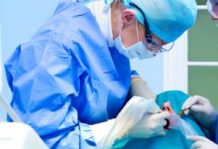The restorative phase is the second part of the periodontal treatment plan, and its goal is to reconstruct lost structures using procedures including occlusal adjustment, orthodontic treatment or the placement of prosthetics/implants.
Surgical phase
- Access surgery and pocket treatment
The aim of a surgical procedure in addition to basic periodontal treatment is to facilitate access for subgingival biofilm removal, while at the same time performing corrective therapy, to make subsequent biofilm control easier for the patient and to prevent the formation of new pathogenic subgingival biofilm.
Determining whether or not surgical treatment is necessary should be done after re-assessing the clinical outcome and response to baseline treatment. This is done approximately 6-8 weeks after having completed this initial phase.
- Regenerative/Mucogingival Surgery
Surgery whose aim is to regenerate the tissues destroyed by periodontal disease. Regenerative surgery, on the one hand, performed with diverse grafting materials, is aimed at reconstructing the tooth attachment apparatus, namely the cementum, periodontal ligament and alveolar bone. Mucogingival surgery, on the other hand, is responsible for improving the soft tissues surrounding teeth with the use of mucous membrane grafts.
- Re-assessment of the surgical phase
Following the surgical phase, the periodontal condition is re-evaluated to verify if the objectives of previous phases have been met and to determine if the next phases can be initiated.
Restorative Phase
This phase of the periodontal treatment plan is aimed at restoring anatomical and functional conditions in patients who have had periodontitis, and who because of their specific traits are at high risk for developing recurrence and its consequent periodontal destruction.
Current corrective treatments mainly involve:
- Permanent prosthetic restoration.
- Occlusal adjustment.
- Orthodontic treatment.
- Implant treatment.
 initiative
initiative 
